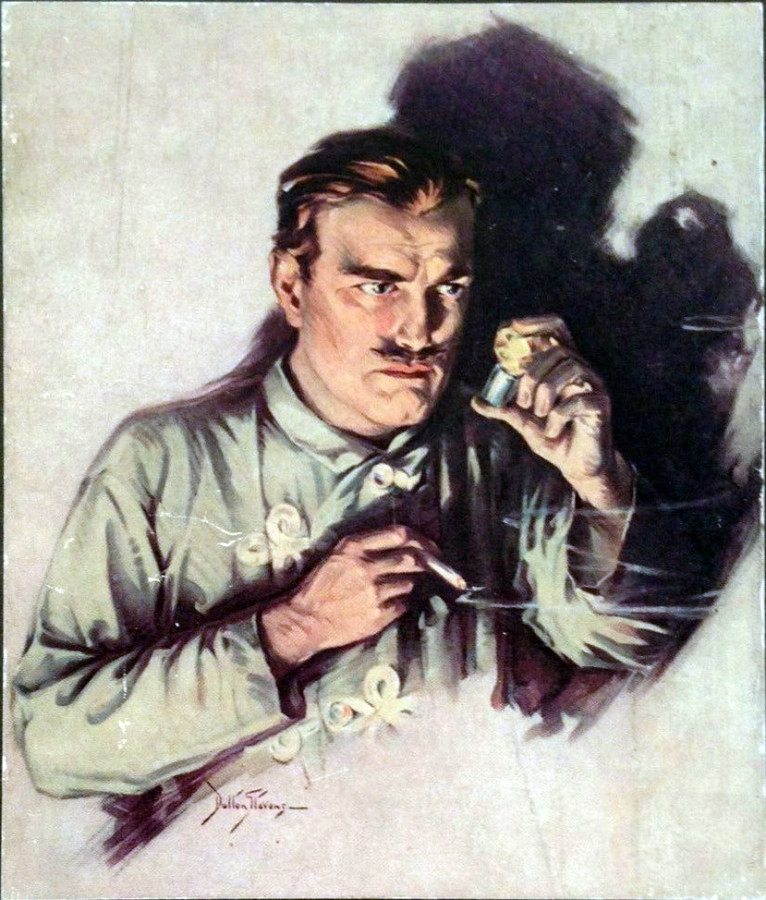Arsène Lupin is a gentleman thief and master of disguise created in 1905 by French writer Maurice Leblanc. In “The Arrest of Arsène Lupin” (“L’Arrestation d’Arsène Lupin”), published in Je sais tout, No. 6, 15 July 1905, during a trip to America, it is learned that famous thief Arsène Lupin has made it aboard the ship. The ship’s guests, led by Bernard d’Andrèzy, try to weed out the thief with only a partial description of his appearance and the first letter of the alias he is using. A woman’s jewels are stolen and d’Andrèzy courts Miss Nelly. Lupin expert inspector Ganimard is at the ships’ destination waiting, and successfully arrests Lupin, who is d’Andrèzy. The jewels, hidden in d’Andrèzy’s camera, are knowingly dropped into the water by the now scornful yet still protective Miss Nelly to eliminate the evidence. The installments that followed are “Arsène Lupin in Prison” (“Arsène Lupin en prison”), “The Escape of Arsène Lupin” (“L’Évasion d’Arsène Lupin”), and “The Mysterious Traveller” (“Le Mystérieux voyageur”), all 1906. Like Pierre Alexis Ponson du Terrail’s Rocambole, Lupin is often a force for good while operating on the wrong side of the law. Lupin also shares similarities with E. W. Hornung’s gentleman thief A. J. Raffles. Several Arsène Lupin novels contain some fantasy elements: a radioactive “”god-stone”” that cures people and causes mutations is the object of an epic battle in L’Île aux trente cercueils; the secret of the Fountain of Youth, a mineral water source hidden beneath a lake in the Auvergne, is the goal sought by the protagonists in La Demoiselle aux yeux verts; finally, in La Comtesse de Cagliostro, Lupin’s arch-enemy and lover is none other than Joséphine Balsamo, the alleged granddaughter of Cagliostro himself.
| Alias Arsène Lupin |
| Real Names/Alt Names Arsène Lupin |
| Characteristics Antihero, Master of Disguise, International Society of Infallible Detectives, Literary Characters, Wold Newton Universe, Belle Époque, French |
| Creators/Key Contributors Maurice Leblanc |
| First Appearance “The Arrest of Arsène Lupin” in Je sais tout (15 July 1905) |
| First Publisher Pierre Lafitte |
| Appearance List Arsène Lupin, Gentleman Burglar a.k.a Exploits of Arsène Lupin a.k.a. Extraordinary Adventures of Arsène Lupin (coll. 9 novellas, 1907); In total, 17 novels, 39 novellas, and 7 novella collections between 1907 and 1941. Film: The Gentleman Burglar (1908), 21 films between 1910 and 1962. |
| Sample Read Arsène Lupin (1909) [Internet Archive] |
| Description Arsène Lupin is a gentleman thief and master of disguise created in 1905 by French writer Maurice Leblanc. In “The Arrest of Arsène Lupin” (“L’Arrestation d’Arsène Lupin”), published in Je sais tout, No. 6, 15 July 1905, during a trip to America, it is learned that famous thief Arsène Lupin has made it aboard the ship. The ship’s guests, led by Bernard d’Andrèzy, try to weed out the thief with only a partial description of his appearance and the first letter of the alias he is using. A woman’s jewels are stolen and d’Andrèzy courts Miss Nelly. Lupin expert inspector Ganimard is at the ships’ destination waiting, and successfully arrests Lupin, who is d’Andrèzy. The jewels, hidden in d’Andrèzy’s camera, are knowingly dropped into the water by the now scornful yet still protective Miss Nelly to eliminate the evidence. The installments that followed are “Arsène Lupin in Prison” (“Arsène Lupin en prison”), “The Escape of Arsène Lupin” (“L’Évasion d’Arsène Lupin”), and “The Mysterious Traveller” (“Le Mystérieux voyageur”), all 1906. Like Pierre Alexis Ponson du Terrail’s Rocambole, Lupin is often a force for good while operating on the wrong side of the law. Lupin also shares similarities with E. W. Hornung’s gentleman thief A. J. Raffles. Several Arsène Lupin novels contain some fantasy elements: a radioactive “”god-stone”” that cures people and causes mutations is the object of an epic battle in L’Île aux trente cercueils; the secret of the Fountain of Youth, a mineral water source hidden beneath a lake in the Auvergne, is the goal sought by the protagonists in La Demoiselle aux yeux verts; finally, in La Comtesse de Cagliostro, Lupin’s arch-enemy and lover is none other than Joséphine Balsamo, the alleged granddaughter of Cagliostro himself. |
| Source Arsene Lupin – Wikipedia |





